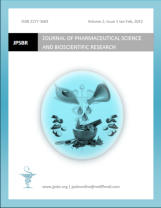




JPSBR
ISSN 2277 - 3681
Volume 2, Issue 1
Pages no. 01 - 39
Available online 13 Feb 2012
Bring your pointer on Abstract to show abstracts
Current issue


Development and Validation of Differential Spectrophotometric method for Determination of Pantoprazole in
Tablet Dosage Form
Jigar Pandya* , Mr. Sagar Solanki, Dr. Mandev Patel
|
Evaluation of Antihypertensive Therapy of Pregnancy Induced Hypertensive (Pih) Patients in Mahila Chiktsalaya,
Jaipur
Jangra Sarita*, Bhyan Bhupinder
|
Comparative study on effect of Natural and Synthetic super Disintegrants in the formulation of Carbamazepine
Fast Dissolving Tablets
Tarun K. Patel, Anandkumar K. Patel*, Vishnu M. Patel
|
Design and development of fast dissolving tablets containing ziprasidone by solid dispersion method
Hrushikesh Dewalkar, Hariprasanna R.C, Upendra kulkarni
|
Isolation of Herbal Plants: Antifungal and Antibacterial Activities
Rathi Sanjesh G *, Patel Kanu R, Bhaskar Vaidhun H
|
Development and evaluation of time controlled pulsatile release Lisinopril tablets
Basawaraj S.Patil*, Abhishek M Motagi, Upendra Kulkarni, Hariprasanna R.C., Shivanand A. Patil
|





Past Issue



















The Simultaneous Estimation of Moxifloxacin Hydrochloride and Bromfenac Sodium in Eye Drops by UV
Alpa N. Parmar*, Rajesh R Parmar, Dr. Vishnu M. Patel , Dr. Dushyant A. Shah
|





© JPSBR Publications 2011-2024
Powered by Opus
ABSTRACT:
A simple, rapid and sensitive difference spectrophotometric method was used for the determination of
Pantoprazole in pharmaceutical dosage forms. The method is based on the induced spectral changes upon
changing the pH of the medium that differ in their UVspectra. Difference spectrum, obtained by keeping
Pantoprazole in 0.1N HCl in reference cell and Pantoprazole in 0.1N NaOH in sample cell, showed two
characteristic peaks at 296 nm and 319 nm with positive and negative absorbance respectively. Difference of
absorbance between these two maxima was calculated to find out the amplitude, which was plotted against
concentration. The calibration curve is linear over the concentration range of 5-25 μg/ml (r²= 0.997), with a
detection limit of 0.15μg/ml. The method was successfully applied to the commercial pharmaceutical drug without
interference from common ingredient accompanying the drug. The result statistically compared with those
obtained by the reference method. The proposed methods were successfully applied to the assay of Pantoprazole
in pure and tablet dosage form. No interference was found from tablet excipients at the selected wavelengths and
assay conditions. The data were compared with those obtained from the spectrophotometric method given in the
literature and no difference was found statistically.
KEY WORDS:
Difference Spectroscopy, Pantoprazole sodium, Tablet.
ABSTRACT:
This study was carried out for providing the better therapy to the pregnancy induced hypertensive (PIH) patients in
India by evaluation of utilization patterns of antihypertensive agents, blood pressure (BP) control and safety profile
of the drugs used among pregnancy induced hypertensive patients in the Mahilya Chikitsalaya Jaipur, a tertiary
obstetrical referral centre in Jaipur. The incidences and characteristics of pre-eclampsia (PE) and eclampsia were
also studied during this study. In this study period 350 prescriptions of PIH patients were analysed carefully to
evaluate utilization pattern of different drugs. Patients who have suffered by (PIH) with blood pressure range of
above 135-145/90-95mmHg were selected and divided in two groups. First group of patients were administered
with the combination of Lebetalol and Nicardipine while Methyldopa and Nifedipine were administered to second
group patients. Every 30 minutes of after 4hrs blood pressure monitored and compliance about disease and drugs
from patients were collected and recorded. Finally statistically analyzed safety and does. The incidences and types
of PE between October 2010 and April 2011 were derived from the pregnancy disease databases. The
characteristics of women with PE in relation to the general obstetric population were analysed on the age, race,
parity, types of delivery, gestation at delivery and mortality. A total of 350 out of 3016 deliveries were complicated
by PIH during the study period. The incidence rate for mild or unspecified PE was 110, while those for moderate
PE, severe and eclampsia were 98 cases, 89cases and 53cases, respectively.
Key words: Hypertension, Pregnancy, Pre-eclampsia, Eclampsia
ABSTRACT:
This present work investigates enhancement of the dissolution profile of Ziprasidone using solid dispersion (SD)
with crospovidone, Mannitol, Polyethylene glycol by using solvent evaporation technique. Solid dispersions were
prepared by solvent evaporation method using solvent methanol in 1:1, 1:2, 1:4, and 1:9 ratio. Dissolution studies
using the USP paddle method were performed for solid dispersions of Ziprasidone at 37 ± 0.5
0
c and 50 rpm in
Phosphate buffer pH 7.4 Fourier transformer infrared (FTIR) spectroscopy were performed to identify the
physicochemical interaction between drug and carrier, hence its effect on dissolution. Dissolution of Ziprasidone
solid dispersion in crosspovidone improved significantly in solid dispersion the 1:9 (ZC8). Thus, the solid dispersion
technique can be successfully used for improvement of dissolution of Ziprasidone.
KEY WORDS: Solid dispersion, Ziprasidone, crospovidone, dissolution enhancement,fast- dissolving tablets.
ABSTRACT:
A direct compression method was used to prepare fast dissolving tablets containing Carbamazepine as a model
drug using natural as well as synthetic superdisintegrants such as isolated mucilage of
Plantago ovata
and
croscarmellose sodium and sodium starch glycolate respectively. Prepared formulations were evaluated for
precompression parameters such as micromeritic properties like angle of repose, %compressibility and Hausner’s
ratio. Tablets were also subjected to postcompression analysis for the parameters such as weight variation,
hardness, friability,
in vitro
disintegration time, wetting time, drug content,
in vitro
dissolution study, and stability
studies. The prepared tablets were characterized by FTIR for drug-excipient compatibility study. No chemical
interaction between drug and excipients was confirmed by FTIR studies. The stability study conducted as per the
ICH guidelines and the formulations were found to be stable. The results concluded that amongst all formulations
prepared with mucilage of
Plantago ovata
showed better superdisintegrating property than the most widely used
synthetic superdisintegrant like croscarmellose sodium and sodium starch glycolate.
KEY WORDS:
Fast dissolving tablets, Carbamazepine, Mucilage of
Plantego ovata
, Croscarmellose sodium, Sodium
starch glycolate.
ABSTRACT:
Aim of this present study was to evaluate the antifungal and antibacterial activity on naturetic plants. The study
was on six naturetic plants like
Sapindus emarginatus,
Hibiscus rosa-sinensis
,
Mirabilis Jalapa
,
Euphorbia tirucalli L
,
Vitex negundo L, Saussurea Lappa Costus
of Methanol, Chloroform, N-Hexane and Water
extracts on various
Aspergillus flavus, Candida albicans Candida glabreta,
fungal
strains
Bacillus subtilis, Escherichia coli,
Staphylococcus epidermidis
bacterial strains using standard methods Agar tube dilution for antifungal, Agar
diffusion assay for antibacterial as per Protocol to determine the Zone of Inhibition.The different concentration of
various plants extracts tested on microorganism for the Zone of inhibition. It shows that water extract of
Sapindus
emarginatus
and
Mirabilis jalapa
reported the highest inhibition against the bacterial organism at 20mm- 23mm
and 16mm-19mm against the fungal strains. The methanol extracts of
Hibiscus rosa-sinensis,
Vitex negundo L,
Saussurea lappa Costus
reported the highest inhibition against the bacterial organism at 23mm- 26mm and 17mm-
20mm against the fungal strains. The n-Hexane extracts of
Euphorbia tirucalli L
report highest inhibition at 21mm-
24mm and 16mm-19mm against the fungal strains.The present study it was conclude that the highest Zone of
inhibition against all different extracts of Plants but there was no response against chloroform extract.
Key words: Zone of Inhibition; Fungal Strains; Bacterial Strains; Extracts.
ABSTRACT:
The objective of present investigation was prepare and evaluate a oral pulsatile drug delivery system based on a
press coated tablet, where a core tablet surrounded coating material. The system consists of two parts, a core
tablet containing the active ingredient and other excipeients, and coating materials consist of hydrophilic and
hydrophobic polymer. The core containing Lisinopril as a bioactive compound was prepared by direct compression
method and evaluated for thickness, hardness, weight variation and friability. The coating materials consisted of
hydrophobic polymer of ethyl cellulose and hydrophilic materials (HPMC 15 CPS) were used in different
concentration. The tablets prepared were evaluated for micromeritic properties (bulk density, tapped density,
Angle of repose and carr’s index), hardness, thickness, weight variation, friability, drug content uniformity and
in-
vitro
drug release study. The drug-excipient study was carried out by using FTIR.
In-vitro
drug release studies were
carried out using pH 7.4 phosphate buffer for 12 hrs. From the obtained results, formulation LC2 was selected as
an optimized formulation for designing pulsatile device.
Key words:
Lisinopril, Pulsatile drug delivery system, lag time,
press coated tablets, HPMC 15 cps.
ABSTRACT:
A simple, rapid, accurate, precise and economical UV spectrophotometric method for the simultaneous
determination of moxifloxacin hydrochloride and bromfenac sodium in combined eye drops using simultaneous
equation method has been developed. The method is based on the simultaneous equations for analysis of both the
drugs using distilled water as solvent. Moxifloxacin hydrochloride has absorbance maxima at 289 nm and
bromfenac sodium has absorbance maxima at 268 nm in distilled water. The linearity was obtained in the
concentration range of 2-10 μg/ml and 4-20 μg/ml for moxifloxacin hydrochloride and bromfenac sodium
respectively. The concentrations of the drugs were determined by using simultaneous equations method. The mean
recovery was 99.64±0.53 and 99.62± 0.04 for moxifloxacin hydrochloride and bromfenac sodium respectively. The
method was found to be simple, accurate and precise and was applicable for the simultaneous determination of






















































































